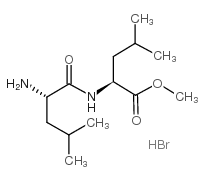L-Leucyl-L-Leucine methyl ester hydrobromide

L-Leucyl-L-Leucine methyl ester hydrobromide structure
|
Common Name | L-Leucyl-L-Leucine methyl ester hydrobromide | ||
|---|---|---|---|---|
| CAS Number | 16689-14-8 | Molecular Weight | 339.26900 | |
| Density | N/A | Boiling Point | N/A | |
| Molecular Formula | C13H27BrN2O3 | Melting Point | N/A | |
| MSDS | Chinese USA | Flash Point | N/A | |
Use of L-Leucyl-L-Leucine methyl ester hydrobromideL-Leucyl-L-Leucine methyl ester (LLOMe) hydrobromide, a dipeptide condensation product of L-leucine methyl ester generated by human monocytes or polymorphonuclear leukocytes, selectively eliminates lymphocytes with cytotoxic potential. L-Leucyl-L-Leucine methyl ester hydrobromide also can induce endolysosomal pathway stress[1][2][3]. |
| Name | Leu-Leu methyl ester hydrobromide |
|---|---|
| Synonym | More Synonyms |
| Description | L-Leucyl-L-Leucine methyl ester (LLOMe) hydrobromide, a dipeptide condensation product of L-leucine methyl ester generated by human monocytes or polymorphonuclear leukocytes, selectively eliminates lymphocytes with cytotoxic potential. L-Leucyl-L-Leucine methyl ester hydrobromide also can induce endolysosomal pathway stress[1][2][3]. |
|---|---|
| Related Catalog | |
| In Vitro | L-Leucyl-L-Leucine methyl ester (1 mM; 0.5-2 h) enhances LRRK2-mediated Rab10 and Rab12 phosphorylation in MEFs and A549 cells[3]. L-Leucyl-L-Leucine methyl ester (10-250 μM; 15 min) is converted to a CCI3COOH-insoluble product by CD4- lymphocytes[2]. |
| References |
| Molecular Formula | C13H27BrN2O3 |
|---|---|
| Molecular Weight | 339.26900 |
| Exact Mass | 338.12100 |
| PSA | 81.42000 |
| LogP | 3.11300 |
| InChIKey | QIPBCIHWFATZOF-ACMTZBLWSA-N |
| SMILES | Br.COC(=O)C(CC(C)C)NC(=O)C(N)CC(C)C |
| Personal Protective Equipment | Eyeshields;Gloves;type N95 (US);type P1 (EN143) respirator filter |
|---|---|
| RIDADR | NONH for all modes of transport |
| WGK Germany | 3 |
| HS Code | 2924199090 |
| HS Code | 2924199090 |
|---|---|
| Summary | 2924199090. other acyclic amides (including acyclic carbamates) and their derivatives; salts thereof. VAT:17.0%. Tax rebate rate:13.0%. . MFN tariff:6.5%. General tariff:30.0% |
|
Inhibition of L-leucine methyl ester mediated killing of THP-1, a human monocytic cell line, by a new anti-inflammatory drug, T614.
Immunopharmacology 49 , 285-294, (2000) T614 (3-formylamino-7-methylsulfonylamino-6-phenoxy-4H-1-benzopyran-4-o ne) is a member of the family of methanesulfonanilide non-steroidal anti-inflammatory drugs (mNSAIDs), most of which act as cycl... |
|
|
Engraftment capacity of mesenchymal cells following hematopoietic stem cell transplantation in patients receiving reduced-intensity conditioning regimen.
Leukemia 20 , 329-335, (2006) The engraftment ability of mesenchymal cells was investigated in 26 patients receiving allogeneic transplantation from HLA-identical siblings with reduced-intensity conditioning (RIC). The stem cell s... |
|
|
Use of granzyme B-based fluorescent protein reporters to monitor granzyme distribution and granule integrity in live cells.
Biol. Chem. 391 , 999-1004, (2010) Reporter proteins comprising granzyme B (GrB) fused to eGFP, ecliptic pHluorin or mCherry, were generated and used to study granule (lysosome) distribution and properties in COS-1 cells and natural ki... |
| methyl 2-[(2-amino-4-methylpentanoyl)amino]-4-methylpentanoate,hydrobromide |
| LLME,HBr Leu-Leu-Ome,HBr |

